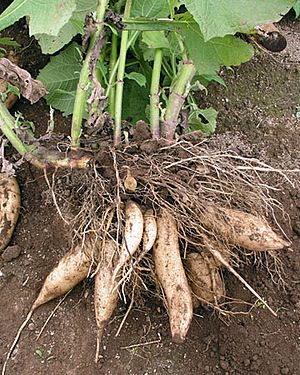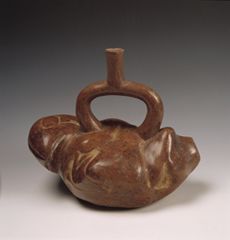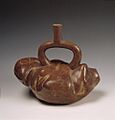Yacón facts for kids
Quick facts for kids Yacón |
|
|---|---|
 |
|
| Roots of yacón | |
| Scientific classification | |
| Genus: |
Smallanthus
|
| Species: |
sonchifolius
|
| Synonyms | |
|
|
The yacón (Smallanthus sonchifolius) is a plant that grows year after year. It belongs to the daisy family. People traditionally grow it in the Andes mountains, from Colombia to northern Argentina. They grow it for its roots, which are crisp and sweet.
Yacón roots are like jícama in how they feel and taste. But yacón has a slightly sweet, flowery taste. This is likely because of something called inulin. Another name for yacón is Peruvian ground apple. The root is mostly water and a type of sugar called fructooligosaccharide.
Farmers in the Andes traditionally grow yacón roots. They grow them at middle heights on the eastern slopes, heading towards the Amazon. Yacón is often grown along the edges of fields. Its juicy roots offer a refreshing snack for farmers working hard. Before the early 2000s, most people outside the Andes did not know about yacón. It was not sold in big city markets. However, news from Japan about its health benefits made it more popular. People in Lima and other Peruvian cities started to know about it.
Contents
About the Yacón Plant
Yacón is sometimes confused with jícama. Jícama is a different plant, a type of bean. But yacón is actually a close relative of the sunflower and Jerusalem artichoke. Unlike many other root vegetables from the Andes, yacón can grow well in many places. It does not need a specific amount of daylight. This means it can grow in warmer areas and mountains.
How Yacón Grows
Yacón is a plant that lives for many years. It can grow up to 2.5 meters (about 8 feet) tall. Its stem is round or angled. It becomes hollow when the plant is fully grown. The leaves grow in pairs on opposite sides of the stem. They are shaped like triangles and have hairs on top.
Underground, yacón has two main parts. It has branching rhizomes, which are like underground stems. These rhizomes keep making new leafy shoots. It also has up to 20 storage roots. These storage roots are the part people eat. They can be up to 25 cm (10 inches) long and 10 cm (4 inches) wide. They can weigh from 0.2 kg to 2.0 kg. Their skin can be white, pink, or brown, depending on the type. If it gets too cold, the parts of the plant above ground will die. But the plant will grow back from its rhizomes when the weather is good. Yacón grows best in temperatures between 18-25 °C (64-77 °F).
Yacón Reproduction
Yacón plants make small flowers at the end of their growing season. When they flower depends on the weather. If conditions are good, flowering starts 6–7 months after planting. It is most active about two months later. The yellow or orange flower head looks like one flower. But it is actually made of many tiny flowers called florets. Each flower head has both female and male florets. The yellow or orange ray florets are female. The yellow-brown disc florets are male.
Seeds are found inside small, dark brown cases called achenes. These are about 2.2 mm to 3.7 mm long. Yacón plants usually do not make many seeds. Some types do not make any seeds at all. Plants grown from seeds take longer to grow than those grown from roots or rhizomes.
Growing Yacón

Yacón is easy to grow in gardens where winters are not too cold. It grows well in places like Kathmandu, Nepal, southern Australia, and New Zealand. These places have mild climates and long growing seasons. Yacón was brought to Japan in the 1980s. From there, it spread to other Asian countries like South Korea, China, and the Philippines. Now, you can find it in markets in those countries. Yacón has also recently appeared in farmers' markets in the United States. You can also find it in health food stores online in the United Kingdom.
You can grow yacón from stem cuttings. You can also use the purple rhizomes found at the bottom of the stalks. The edible roots themselves will not grow new plants. If you leave them in the ground, they will rot and help fertilize the soil for future plants.
Outside its native home, yacón is planted in early spring. This is usually around the time of the last frost. Cold temperatures can harm the parts of the plant above ground. But the roots are safe unless they freeze solid. Yacón grows very fast, much like Jerusalem artichokes. The plants grow best with fertilizer.
After the first few frosts, the top parts of the plant will die. This means the roots are ready to be dug up. You can leave some rhizomes in the ground to grow next year's crop. Or, you can store them in a refrigerator or bury them away from freezing temperatures until spring.
Yacón's Special Qualities
The makeup of yacón can change. It depends on where it grows, how it is farmed, the season, and when it is harvested.
Yacón roots are mostly water and carbohydrates. About 70% of a fresh root is water. This means it does not have a lot of calories. The dry part of the root is 40-70% fructooligosaccharides. These are special sugars that are not harmful. They are not easily digested, but they taste sweet. Yacón also has simple sugars like sucrose, fructose, and glucose. The roots are rich in calcium and potassium. Yacón juice also has many important amino acids.
Helpful Compounds in Yacón
Yacón roots and leaves have special compounds. These are called bioactive compounds. Many of the good effects of eating yacón come from these compounds.
The main compounds that fight damage in the body are chlorogenic acid and L-tryptophan. Yacón also has other plant compounds called phenolics. These phenolics help good bacteria grow. They also stop harmful germs from attacking the plant. Phenolics in yacón leaves and bark give it a sharp taste and a special smell. When yacón roots are damaged, these compounds can make them turn greenish or black.
How Yacón is Used
Yacón is grown in many countries for food and for health reasons. Since the 1960s, this plant has spread from South America to places like New Zealand and Japan. This has led to many different ways of using it.
Food and Storage
You can eat yacón roots in many ways. They can be eaten raw, boiled, or roasted. People also make them into drinks, jams, syrup, vinegar, flour, chips, and juice. When eaten fresh, they are sweet and crunchy.
The roots are ready to eat fairly early in the season. But they taste much sweeter after they have grown fully. They also taste better after a light frost. After harvesting, if you leave the roots in the sun, they will become even sweeter.
You can store harvested yacón roots for several months. However, the amount of fructooligosaccharides will go down over time. If you store them at 1 degree Celsius (about 34 degrees Fahrenheit), the sweet sugars will change more slowly.
Medicinal Use
Yacón is believed to have many health benefits. The roots contain special plant compounds and high levels of fructans. These are thought to be good for human health. Yacón leaves have been shown to protect cells and help lower high blood sugar. Yacón products are often studied for their use in medicine. This is because they may help with diabetes and lower blood sugar. In traditional Andean medicine, yacón is used for liver and kidney problems. In Bolivia, it is used for diabetes and digestion issues.
Religious Use
In the past, during colonial times, eating yacón was linked to a Catholic celebration. This celebration happened at the same time as an older Inca festival. In the Moche era, yacón might have been food for special events. People might have placed models of food, like yacón, in Moche burials. This could have been to feed the dead, or as gifts to gods. Moche people showed yacón on their pottery.
Yacón Plant Problems
Yacón plants can get sick from different things. These include tiny worms called nematodes, bacteria, fungi, viruses, and insects.
A type of nematode called the root-knot nematode can harm yacón plants. It causes poor growth and bumps on the roots. To grow more yacón, it is important to use healthy plants. One safe way is to take small shoots from the plant. Then, clean them with a special solution.
A fungus called Rhizoctonia sp. can cause the roots and base of the yacón plant to rot. If half of the roots are infected, they cannot be sold or eaten. This rot and discoloration can affect the roots and other parts of the plant. So, using clean and healthy yacón parts for planting is important. This helps stop diseases from spreading.
Insects like the sunflower caterpillar can also damage yacón. They eat the leaves. Farmers can use natural enemies of these insects. They can also plant "trap plants" like sunflowers between yacón plants. Sunflowers are more attractive to these insects. This means fewer insects will eat the yacón plants.
Also, different viruses can infect yacón. The Yacon necrotic mottle virus can make yacón leaves turn yellow, get spots, and become small or misshapen. Another virus, Yucca bacilliform virus, causes yellow spots on the leaves. These spots spread along the leaf veins and get worse towards the tips. Eventually, the spots turn black.
Images for kids
See also
 In Spanish: Yacón para niños
In Spanish: Yacón para niños







